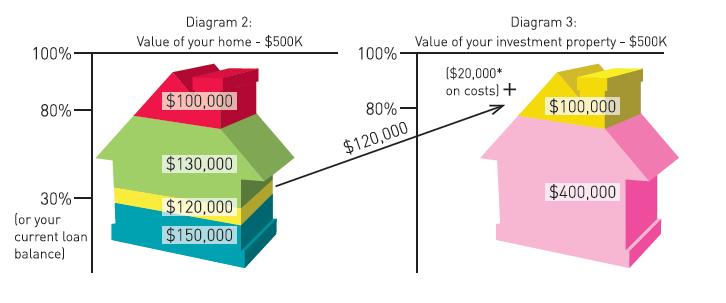Getting ahead financially is becoming further and further out of reach for many Australians. However many are now tapping into their “pot of gold” – the equity in their home – allowing them to invest for the future and forge ahead financially.
Diagram 1 illustrates the financial components of your home:
• Existing borrowings – represented by the blue section of your home.
This is the amount of your loan not yet repaid. This loan amount unless used to purchase an investment property) is not usually tax deductible.
In this example, if your home was worth $500,000 and you had $150,000 remaining on your loan, your existing borrowings would represent 30% of your home value.
• 20% equity – represented by the red section of your home.
This is the safety net that lending institutions like to have as their safeguard against the borrowings on your home.
Usually this safety net represents 20% of the home value required in equity that is unable to be touched unless you want to pay LMI (Lenders Mortgage Insurance).
In this example 20% equity of $500,000 is $100,000
• Remaining equity (what you’ve already repaid on your loan or gained through capital growth on the property) – represented by the green section of your home
In this example it shows that the remaining 50% of the value of the home is available to use as security for other purchases. To access this remaining equity (in this example) to purchase an investment property, there are two options: (A) establish a line of credit; or (B) apply for a standard term loan with a redraw facility or an offset account where the remaining equity amount can be invested until required.
Typically the existing loan (blue) and the new portion of the loan (green) would be refinanced; however it is common to split these and create separate sub-accounts in order to keep the non tax deductible (blue) amount clearly differentiated from the deductible (green) investment amount. Your accountant should be able to help with this.
In this example, $250,000 is 50% of the value of your home available to purchase an investment property.
The example continues with the purchase of an investment property for the sum of $500,000. When you do find the investment property you want to purchase, you can fund the acquisition with:
(A) A new loan for the investment property (typically 80% of the purchase price to avoid LMI).
“All you need to do is sit back and let the property take its course with capital gains generating some additional equity over the next seven to ten years, as it has proved to do so (even in tough times) over the last century”
This $400,000 loan is represented by the pink section of the investment property in Diagram 3. Plus, (B) Part of the green remaining equity in your home. The remaining 20% of the purchase price (usually representing the deposit) plus stamp duty, conveyancing costs and other associated expenses can be taken from this equity.
In the example it would require you to draw $120,000 (assuming $100,000 [20% deposit] and $20,000 [5% total acquisition costs*]) of the available $250,000 (represented by the yellow section in diagram 2) leaving $130,000 of the remaining equity. This could also be used to purchase an additional investment property if serviceability allowed or you could use this equity to fund any shortfall in your new investment loan repayments.
The tax man (through tax rebates) and your tenants (through rent) help pay for the new loans; however sometimes there is a shortfall that needs to be serviced.
This should be taken into account when borrowing to ensure that the loan on the investment property can be serviced within your budget and should include some margin for any unexpected interest rate rises.
Then all you need to do is sit back and let the property take its course with capital gains generating some additional equity over the next seven to ten years, as it has proved to do so (even in tough times) over the last century.
Once you learn this strategy you can repeat it as often as you want, provided you can re-pay the borrowings.
Disclaimer: *Acquisition costs vary in each state. For demonstration purposes only, we’ve assumed 5%.
To learn more about investing in property and using the equity in your home please contact the office for a no obligation consultation to discuss your personal situation and future goals.
